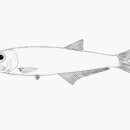Diagnostic Description
provided by Fishbase
Belly with 16 or 17 (rarely 19) + 9 to 11, total 26 to 28 (rarely 30) scutes. Lower jaw not strongly projecting; strong conical teeth in both jaws, continued as large and small teeth along maxilla blade. Easily recognized by large, canine-like teeth in both jaws (Ref. 26938). Dorsal fin origin behind midpoint of body; anal fin moderately long, its origin below or in front of dorsal fin origin.
- Recorder
- Crispina B. Binohlan
Morphology
provided by Fishbase
Dorsal spines (total): 0; Analspines: 0; Analsoft rays: 38 - 44
- Recorder
- Crispina B. Binohlan
Trophic Strategy
provided by Fishbase
In Southwestern Atlantic preys on proportionally large clupeoid fishes and caridean shrimps. Fishes are distinctively folded in the stomachs of this herring, in about 90% of the cases with their heads and tails pointing head-wards the predator. This herring stands out as the only small-sized species among the predaceous fish-eating clupeiforms. The well developed canine-like teeth are likely related to a piscivorous diet and may play a role in the folding and orientation of fish during prey handling and swallowing (Ref. 51383).
Biology
provided by Fishbase
Occurs in coastal areas, but also in lagoons and off river mouths, perhaps entering water of lowered salinity (Ref. 12225). In Southwestern Atlantic preys on proportionally large clupeoid fishes and caridean shrimps. Fishes are distinctively folded in the stomachs of this herring, in about 90% of the cases with their heads and tails pointing head-wards the predator. This herring stands out as the only small-sized species among the predaceous fish-eating clupeiforms. The well developed canine-like teeth are likely related to a piscivorous diet and may play a role in the folding and orientation of fish during prey handling and swallowing (Ref. 51383). Spawns during the northern winter (Ref. 37032).
- Recorder
- Crispina B. Binohlan
Importance
provided by Fishbase
fisheries: subsistence fisheries
- Recorder
- Crispina B. Binohlan
Dogtooth herring
provided by wikipedia EN
The dogtooth herring (Chirocentrodon bleekerianus) is a species of herring occurring in the Caribbean Sea and the Atlantic Ocean along the coast of northern South America, Central America and the Caribbean islands. It is the only species in its genus. They are commonly around 3.5 inches (9 cm) in length.
References

- license
- cc-by-sa-3.0
- copyright
- Wikipedia authors and editors
Dogtooth herring: Brief Summary
provided by wikipedia EN
The dogtooth herring (Chirocentrodon bleekerianus) is a species of herring occurring in the Caribbean Sea and the Atlantic Ocean along the coast of northern South America, Central America and the Caribbean islands. It is the only species in its genus. They are commonly around 3.5 inches (9 cm) in length.
- license
- cc-by-sa-3.0
- copyright
- Wikipedia authors and editors

